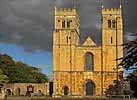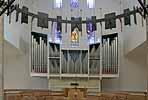 Worksop Worksop
Priory
Organ
Worksop has possessed an organ since at least 1568, when Thomas Totyll the organ maker was paid £10 3s ‘for mendyng the organs & for his borde’. There have been several repairs and replacements since that time, but the current organ dates from the 1974 extension and comprises:
Great Organ |
Swell Organ |
Pedal Organ |
Principal |
8ft |
Wood gedacht |
8ft |
Subbass |
16ft |
Rohr Flute |
8ft |
Spitz gamba |
8ft |
Octave |
8ft |
Octave |
4ft |
Principal |
4ft |
Subbass |
8ft |
Spitz Flute |
4ft |
Koppel Flute |
4ft |
Wide Octave |
4ft |
Quint |
2⅔ft |
Octave |
2ft |
Mixture III |
|
Wide Octave |
2ft |
Spitz Squint |
1⅓ft |
Sordun |
32ft |
Tierce |
1¾ft |
Scharf III-IV |
1ft |
Fagot |
16ft |
Mixture III-V |
2ft |
Dulzian |
16ft |
Trumpet |
8ft |
Trumpet tremulant |
8ft |
Schalmay tremulant |
8ft |
|
|
 The organ case was designed by the builders (Peter Collins of Melton Mowbray) in close cooperation with the architects. Although painted, it is constructed of mahogany for its main members, with pine-cored blockboard for its panels. The case is said to have a tonal as well as architectural function, mixing the sound of the various pipes then projecting it forward as a whole. The organ case was designed by the builders (Peter Collins of Melton Mowbray) in close cooperation with the architects. Although painted, it is constructed of mahogany for its main members, with pine-cored blockboard for its panels. The case is said to have a tonal as well as architectural function, mixing the sound of the various pipes then projecting it forward as a whole.
There are 1634 pipes of various materials ranging in tin content from 90% in the façade pipes to 20% for some of the flute stops, with copper and pine also used for certain other registers. Apart from 24 small pipes in the pedal case, all the front pipes are speakers. For the mechanism of the key and pedal action, direct connection by trackers of thin wood are used to the control valves. The stop action is electric with five pistons to each department.
|